In the 1970s, consumers saw about 500 ads a day. Fifty years later, that number is 5,000. Marketing campaigns, and their related advertisements, are everywhere. Social media, radio, freeway billboards, subway station ads—they all clamor for attention as we go about our day.
And while the landscape can be noisy, it’s possible—with a creative idea—to intercept a consumer’s daily routine and convince them to think about your product. The key is multichannel marketing—the act of promoting your products wherever your customers buy.
Here’s how to create a multichannel marketing strategy that reaches your target audience across the channels where they already engage (and are primed to interact with you).
✂️ Shortcuts
What is multichannel marketing?
A multichannel marketing strategy promotes products anywhere your customers buy. Beyond advertising, it brings commerce to the channels where your target market already spends their time. This includes:
-
Social media
-
Messaging apps
-
Google Shopping ads
-
Direct mail
-
Mobile push notifications
-
Billboards, radio, and TV ads
-
Online communities
“Taking a multichannel marketing approach is paramount to reaching and activating customers, as the buying journey for most products and categories is long and often requires consideration across channels.” —Dan Gray, CEO of Vendry
Growth often stalls when a website and direct-response advertising are your only means of reaching shoppers. That’s why you need to consider a multichannel and online-to-offline (O2O) strategy.
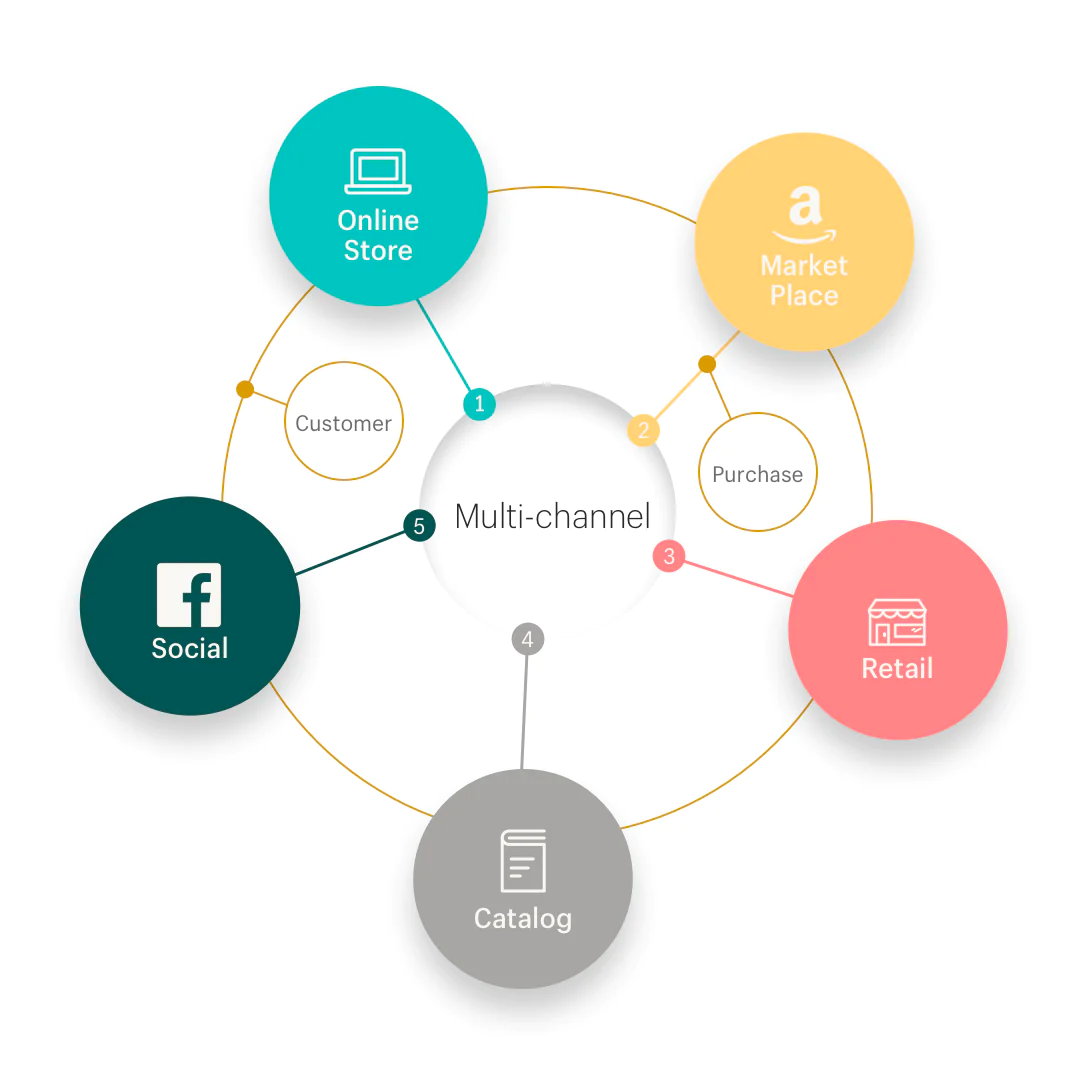
Multichannel marketing meets customers where they are.
The benefits of a multichannel approach
The best brands sell to their customers wherever they consume content. When you create natural purchase paths on those channels, multichannel marketing comes to life.
Dan Gray, CEO of Vendry, says, “Taking a multichannel marketing approach is paramount to reaching and activating customers, as the buying journey for most products and categories is long and often requires consideration across channels.
“For example, when purchasing clothing, consumers are often considering signals from organic social media, paid ads, editorial content both from press and affiliates, as well as plenty of other sources.. By not participating across those channels, you are risking diluting your place in the customer’s search and losing the purchase.”
Aside from reaching customers on the channels they’re already using, repeatedly positioning your brand in front of its target audience builds recognition. Customers will come to know your brand, the types of product you sell, and the mission you stand for. This strong brand consistency can increase revenue by up to 20%.
This pays dividends for merchants: multichannel customers spend more than their single channel counterparts, boasting a 30% higher lifetime value.
Of course there are also challenges when you engage in multichannel marketing.
Too many channels, too few resources
The rise of TikTok proved how the social media landscape can change dramatically over a short period of time. The platform went from 85 million users in the first quarter of 2018 to 333 million one year later.
Subsequent apps have followed in TikTok’s footsteps. Others, however, have had an upward trajectory, only to lose momentum just as fast as they skyrocketed, such as the audio platform Clubhouse.
A big challenge for many multichannel marketers is determining which new, buzzworthy platform is worth investing in. Is it worth drawing already-limited resources away from a platform that’s proven to work to experiment with an upcoming one?
Sebastian Cruz Couture founder Cesar Cruz echoes the idea that one of the biggest challenges of multichannel marketing is taking on too many channels: “Many ecommerce businesses bite off more than they can chew, resulting in social platforms that aren’t regularly updated and product pages with grammatical errors.”
“Only take on as many channels as your team can handle,” Cesar recommends. “For instance, as your team grows, you can consider expanding your marketing budget or adding a new social media platform to the mix if that makes sense—but your strategy needs to fit within your team’s means.”
With Shopify, however, you can manage all sales and marketing channels within your existing ecommerce platform. Run Google Shopping ads, sync inventory across your social media storefronts, and monitor multichannel performance without leaving the dashboard your team already knows and loves.
Attribution
With multichannel marketing, people might have several interactions with your brand before deciding to purchase. The problem, however, is that most analytics platforms use a last-touch attribution model—the last channel your customer engaged with gets full credit for the conversion.
At first glance, this can look like channels used by customers at the top of the marketing funnel aren’t useful. The opposite is true in reality. Customers might not have purchased through their final channel if they didn’t see the product, get to know your brand, or read customer reviews on other preconversion channels.
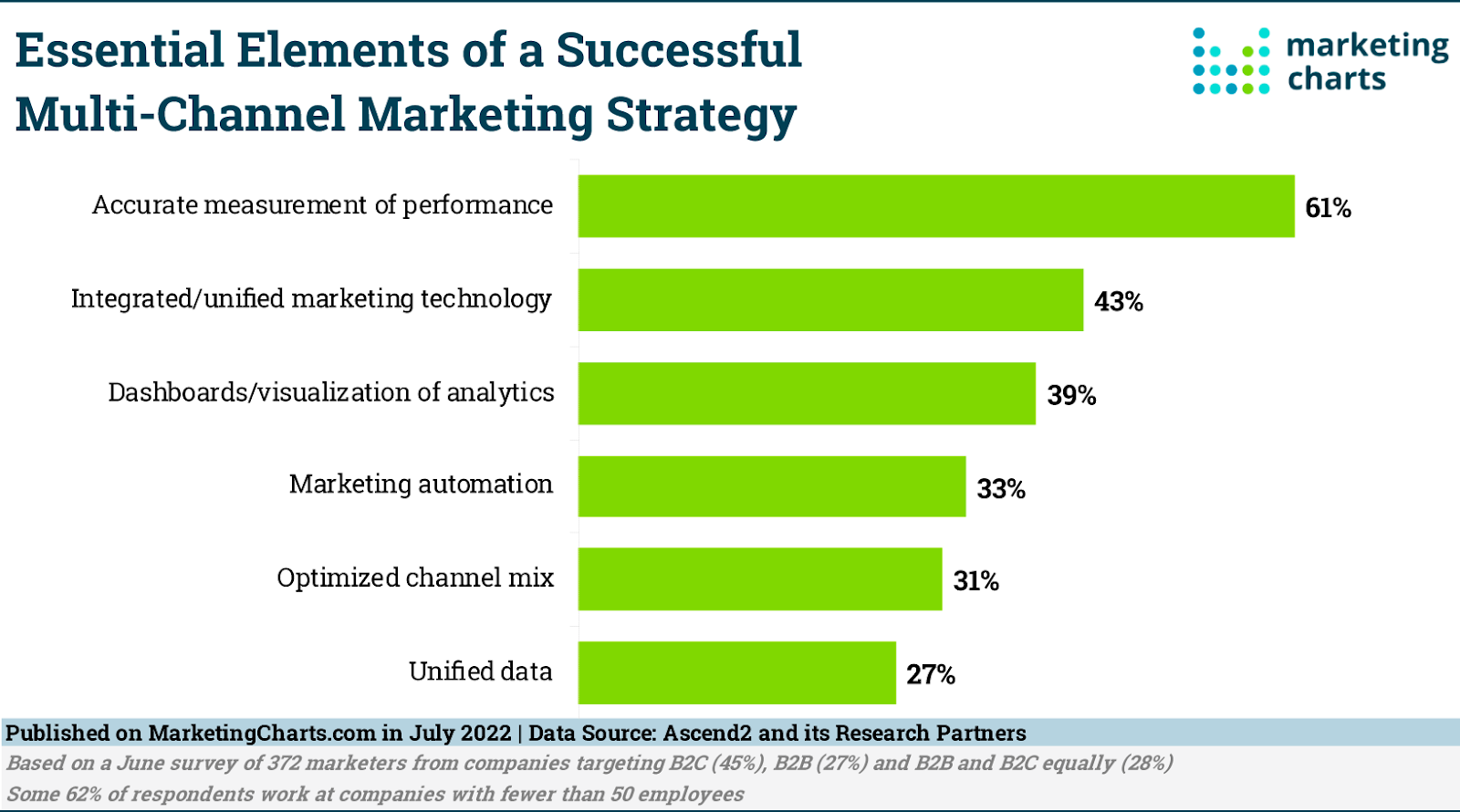
MarketingCharts reports 61% of marketers think accurate measurement of performance is the most important element of a multichannel marketing strategy.
Geoff Haigh, head of operations at 10 Yetis, says, “Tracking sales origins in the modern era is every ecommerce analyst’s nightmare right now. We live in an era where the likes of mobile phone companies are battling against each other by using privacy as a bargaining tool to try and hook consumers in.
“This means that tracking data robustly and confidently can become an issue. In a world where the number one marketing mantra is ‘know your audience,’ that knowledge has been diluted to the point where it’s near impossible to track personal preferences or affinities.”
Solve this challenge with a multichannel attribution model. Google Analytics is often set to single-touch attribution by default, though you can change this to a cross-channel position-based model. It gives 40% of the conversion credit to the first and last touchpoints a customer has, with the remaining 20% split amongst the middle.
How to craft a multichannel strategy
-
Define clear brand guidelines
-
Set up user tracking
-
Use a product information management tool
-
Identify customer intent by traffic source
-
Promote previously viewed products
-
Drive multichannel visitors to email
-
Set up multichannel marketing attribution
Define clear brand guidelines
Brand is a key differentiating factor for modern commerce businesses. With a constant onslaught of emerging brands that undercut other merchants on price, strong branding can assist in retaining existing customers and help you stand out from those 5,000 marketing messages pelting your customers every day.
A strong brand has a strong foundation—a set of values, a mission, and an identity that customers can connect with.
Patagonia, for example, prides itself on sustainability. Its Worn Wear program encourages customers to share how they’ve bought or resold Patagonia clothing through the brand’s resale platform.
This video, posted in full on YouTube, has been repurposed into short-form videos and images designed to capture more consumers across other channels. Each relays the importance of protecting the environment and how the brand’s resale program plays into that wider mission shared by its target audience.
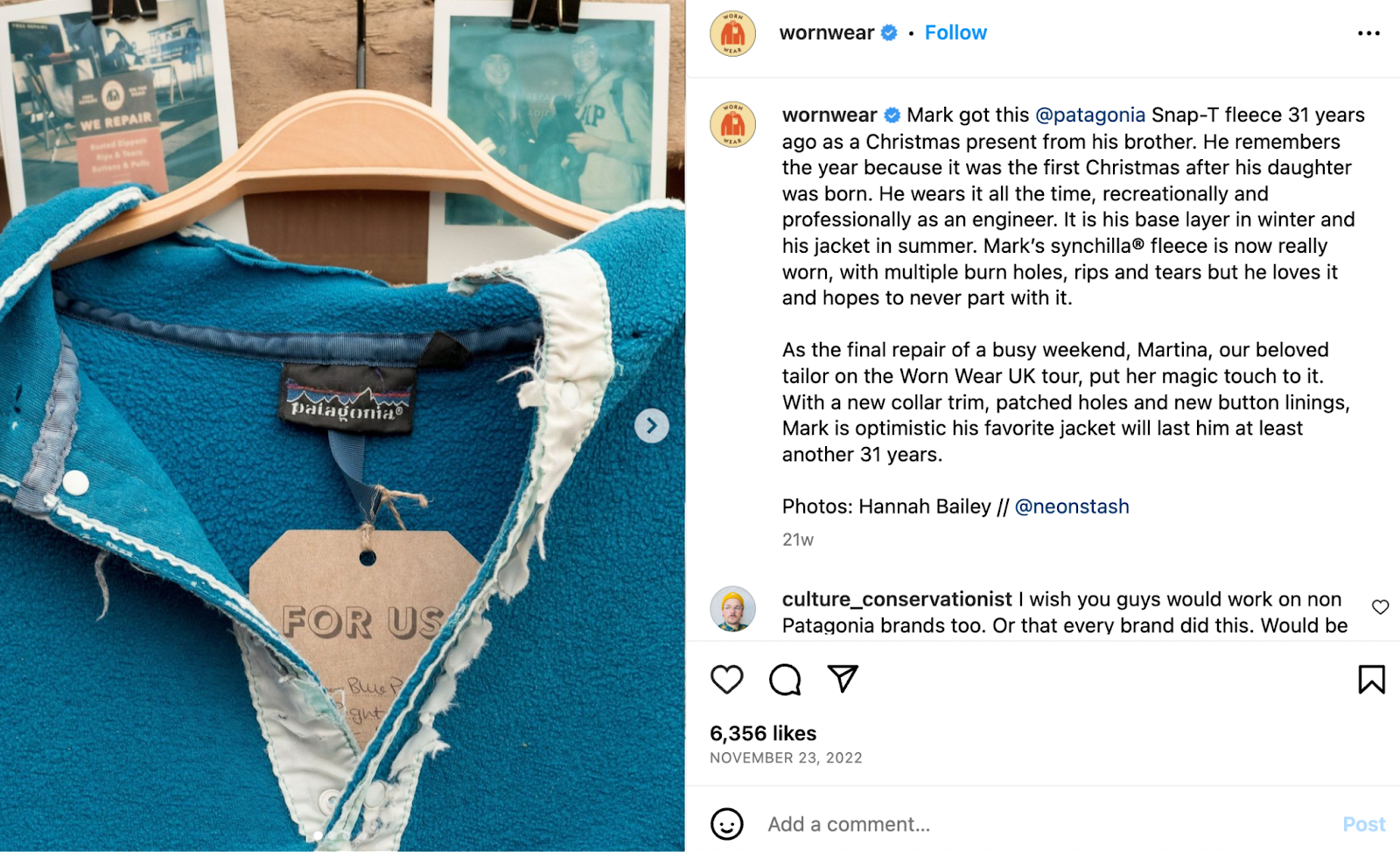
Patagonia repurposes its Worn Wear content on Instagram.
Some 84% of businesses we surveyed said a connected brand experience across channels will be even more important to the future of commerce than it has been in recent years. Brand guidelines document these principles to ensure cross-channel consistency.
Make your brand guidelines clear and accessible to the entire marketing team. Provide examples of what on-brand content looks like for you, including any topics to steer clear from. Only publish content that aligns with these guidelines to provide the same brand experience to potential customers regardless of where they interact with you.
Set up user tracking
Multichannel retailers connect with customers at various stages of the sales funnel, using different types of content across several channels. User tracking helps keep tabs on these customers.
User-IDs
Within Google Analytics, User-ID enables near-comprehensive identification so that a visitor’s browsing sessions on desktop, mobile, and elsewhere are logged under the same umbrella.
“If you’re a retailer,” says Peter Northrop Jr., former new media and content marketing manager at BounceX, “there’s zero reason not to implement User-ID. Zero. Absolutely none. There are no privacy issues, and you could use that information to essentially do a lot of amazing things from a measurement and then a testing perspective.”
UTM parameters
UTM parameters are a staple of smart ecommerce. They’re tags added to URLs so that, when a link is clicked offsite, a trackable note is sent to your Google Analytics dashboard.
“We add this tracking on all our links so when someone actually comes to our site, we know what drove them there,” explains Marc Weisinger, director of merchant revenue acceleration at Shopify. “This was the campaign that they came from, so if that was a branded search campaign and they know our name beforehand, that tells us a lot of information about someone.”
Use a product information management tool
Hoop Mobb is one merchant using a multichannel marketing approach. Owner Donyale Walton says each channel has its own advantages that a single-channel strategy simply couldn’t provide: “We have a Facebook group with just under 6,000 members and we asked which communication method they like the most, and the majority responded with SMS.”
Plus, with livestreaming, Hoop Mobb sees an influx in sales because, according to Donayle, “People get to ask questions and get a better look at our products.”
However, Donayle says the biggest challenge with multichannel marketing is cohesiveness. “Small things like not including ‘while supplies last’ on all marketing channels can impact sales and customer service,” Donayle says.
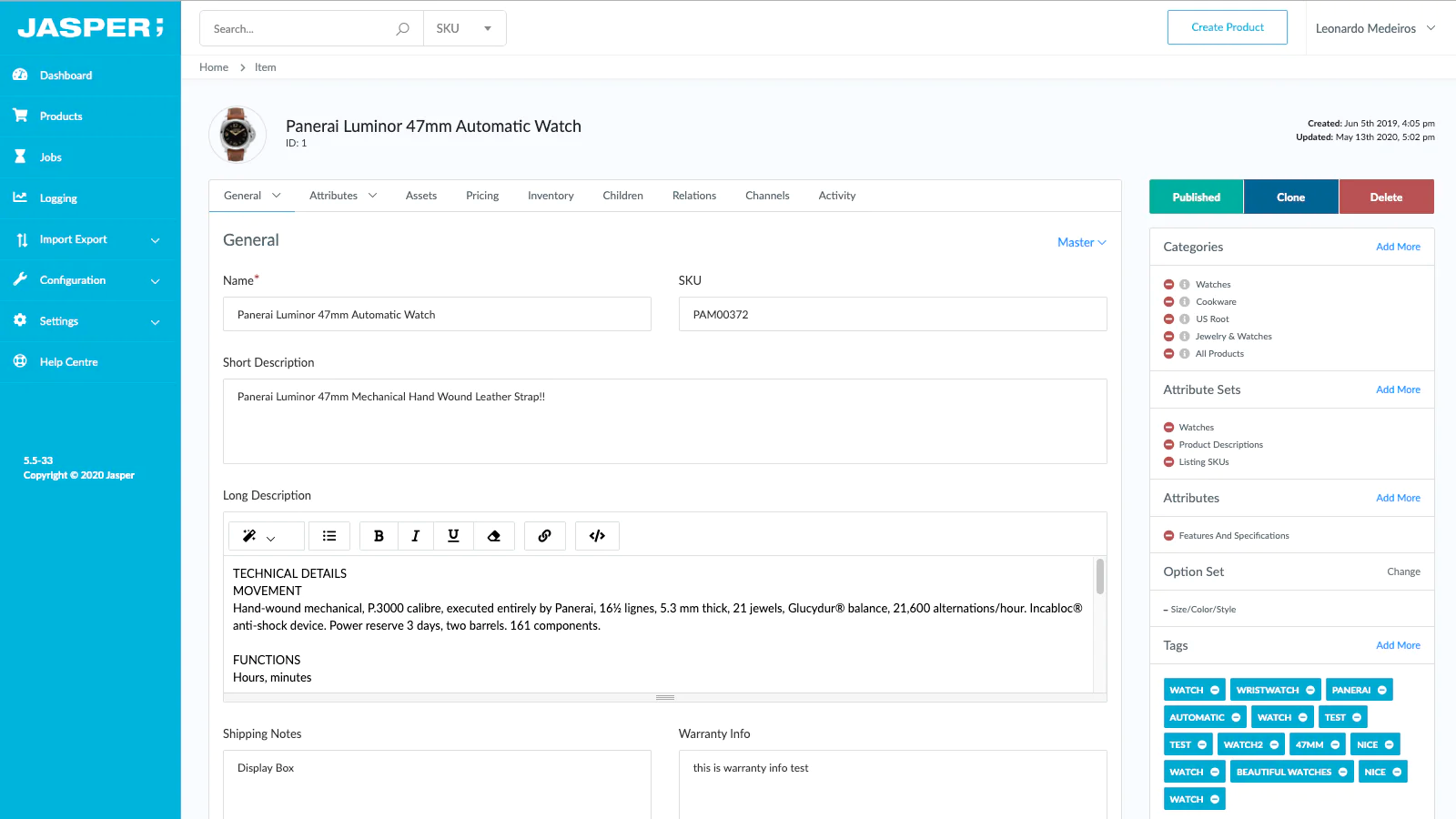
Jasper PIM integrates with Shopify.
A product information management (PIM) tool exists to solve this problem. It stores key product data all in one dashboard and syncs up-to-date information across each sales channel. That includes:
-
Product descriptions
-
Product images
-
Product availability
-
Product specifications (e.g., weight, size, materials)
-
Localized data (e.g., currencies, taxes, or translated descriptions)
-
Shipping information
-
Coupons or discounts
Choose a PIM that integrates with Shopify to ensure consistency across all marketing channels. Popular options include Jasper PIM, Sales Layer, and Salsify. Each acts as a central repository for product-related information your marketing team can reference when publishing marketing materials across a variety of channels.
Identify customer intent by traffic source
Whether visitors come to your site through organic search, social media, or paid advertising, each channel tells a slightly different story. Unfortunately, few sites take advantage of that story by leveraging a psychological principle known as “consistency and commitment.”
Identify your most-valuable audiences and how to harness that data for growth. Rather than treat all visitors the same, build a multichannel marketing strategy around identifying customer intent via their traffic source.
Serve up custom content so a visitor’s first impression aligns with where they came from. For instance, if Pinterest is how they got to your page, you can queue up a scroll-delayed overlay with a message. This example names the platform they arrived from and gives a platform-specific coupon code exclusive to those visitors.
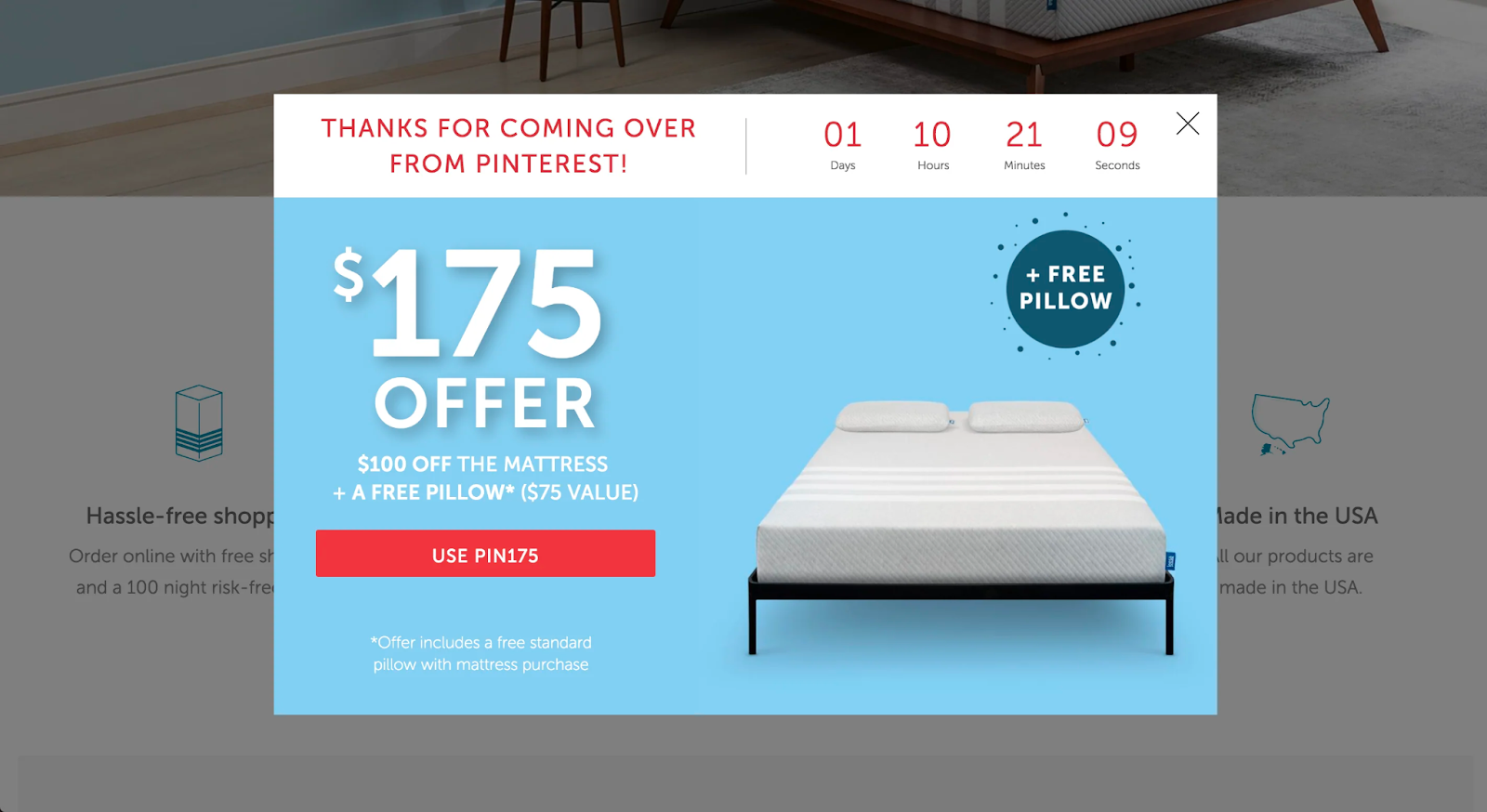
This pop-up references a user’s traffic source in the coupon.
It’s a welcome and relevant personal touch that builds on the micro-conversion the visitor has already taken—clicking on your link from Pinterest—and moves them toward the macro conversion of becoming a buyer.
Promote previously viewed products
A multichannel strategy may span far and wide, but it must be brought home under one simple ethos: convenience. That means streamlined checkouts are important. Give them more ways to pay. Fewer fields to fill out. Less friction will net greater conversion.
“It’s going to be the convenience revolution,” said Marc Weisinger. “That’s going to be the thing that makes brands win the most. So, checkout has to be as quick as possible, mobile checkout has to have as few forms as possible and as many different payment options as possible.”
Convenience for a customer means making your product the right product for them to buy at that moment. Each buying journey may not be the same, but for your customers, it should feel like an intuitive process every time.
To ensure no wasted movement or repeated communication, the smartest companies lean on omnichannel practices to segment customers based on their previous interaction with a product.
Identify who is getting your ads first, then deploy content-specific messaging so your retargeting efforts are not in vain. On Facebook, for instance, you might create separate ads or campaigns to retarget:
-
Recent visitors to product or category pages (0–7 days)
-
Non-recent visitors to product or category pages (8–30 days)
-
First-time customers to recommended products
-
Recurring customers to new releases
-
Long-term customers to loyalty programs
Drive multichannel visitors to email
Customized experiences based on channel source won’t allow you to unmask the people your multichannel strategy is designed to serve. Capturing a visitor’s email address, however, is the holy grail—the organizing principle around which multichannel marketing rotates.
“Let’s make sure that you are getting as little anonymous traffic on your site as possible,” Marc Weisinger drives home. “So, when you’re looking at an attribution model, one of the main conversion goals you can possibly have is grabbing that email address. And once you have that, it opens up a whole world of testing and understanding someone’s complete user journey across your website.”
The way to do this is through triggered overlays built on a visitor’s real-time behavior. Entry overlays have been an online staple for years, but that doesn’t mean they need to be bland:

Pura Vida Bracelets’ “Spin to Win” wheel boasts a submission rate of 24.1% across devices.
Entry overlays are just the beginning. A behavioral-based approach to capturing a visitor’s email address would also rely on overlays triggered by:
-
Scroll depth or time on page
-
Multiple page views of products or collections
-
Out-of-stock items or sizes
-
Returning visitors who have yet to identify themselves
-
Contextual overlays based on product types
-
Popular on-site search terms
-
Interactive content (i.e., quizzes)
-
FAQ clicks, like size, customer reviews, and onsite chat
Alternatively, when an anonymous visitor moves their cursor to close a window, trigger an exit-intent box to appear. But rather than give those exiting the same treatment as those entering, the incentive and urgency of an offer need to be turned up—especially if something has been added to cart.
Bubs Naturals, for example, uses an exit intent pop-up that offers customers a 15% discount when they display an intention to leave the site:

Bubs Naturals’ exit intent pop-up.
Set up multichannel marketing attribution
Having the right multichannel identification in place comes with a wealth of customer data, and it’s up to the merchant to know what to do with it.
Take the Amazon Go storefront, for example. No cashiers. No checkouts. No lines. You just walk in, pick out what you want, and everything else takes place via your smartphone.
Luckily, the multichannel backbone of Amazon Go isn’t beyond the reach of other retailers. “They know your email, they know who you are, so how does Amazon then use that data to change what you actually see on Amazon.com?” Marc Weisinger asks. “By getting an input and changing an output. It’s about finding the right experimental model that works.”
For most multichannel strategies, the website will be the hub that channels unify around. Channel unity hinges on proper branding, focused and dedicated messaging that broadcasts consistency across all your sales channels, yet that is not a company’s only hope to ensure cohesion across all its sales platforms.
To make channels work together, technology is your friend. Multichannel software can organize and manage channels all through one dashboard, where you can edit listings, change item descriptions, and—above all—measure bottom-line effectiveness.
On Shopify, this can be done through the “Sales by channel report” or “Sales by traffic referrer” (including custom coupon codes to track specific campaigns):
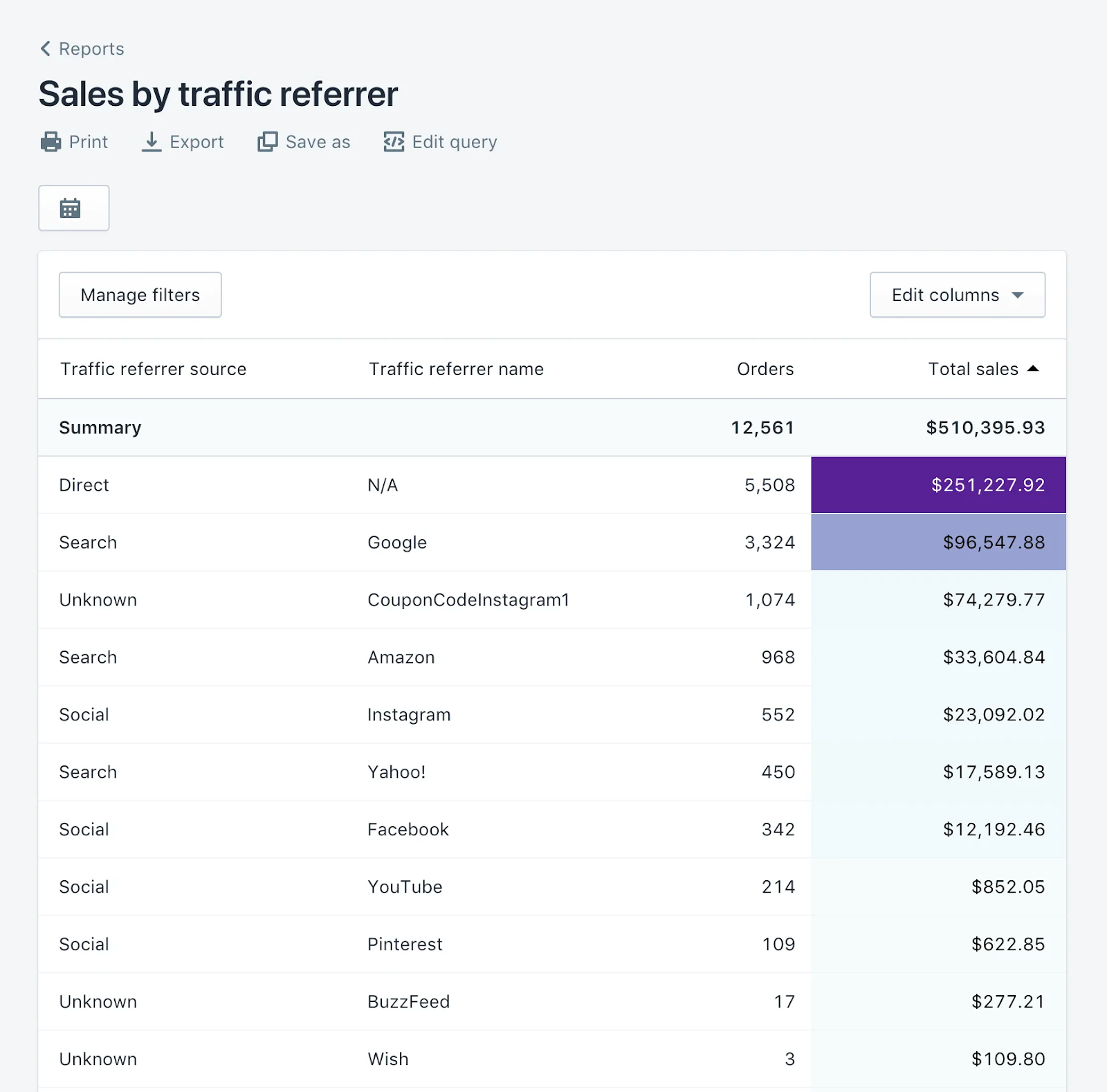
Shopify breaks down how sales come to your website.
What to look for in a multichannel marketing platform
The toolstack that powers your business is just as important as the products you sell. Here’s what to look for in a multichannel marketing platform.
-
Social commerce features. Social media sales are predicted to top $80 billion by 2025. Capture the 82% of social media users who buy through social media storefronts by syncing your ecommerce store with platforms like Facebook and Instagram.
-
Native email marketing. Encourage multichannel visitors to turn into customers through intuitive pop-ups and email marketing. Shopify integrations with email marketing services like Klaviyo, Drip, and Omnisend transfer data from your ecommerce website to retarget customers based on the cross-channel touchpoints they’ve already had with your brand.
-
Product information management. Keep campaign messaging—particularly product-specific data—consistent across all channels. Shopify integrates with a suite of PIM tools to ensure consistency.
-
Automated workflows. Save time and reduce manual error with workflow automation. If a product sells out, for example, you don’t want your marketing team to continue promoting it. Use Shopify Flow to automatically hide the out-of-stock item. When your back end shows inventory has been replenished, it’ll revive the product listing and notify your marketing team.
-
Multichannel analytics. Shopify’s native dashboards show the top-line impact of your multichannel campaigns. Its Google Analytics integration is on-hand for further investigation using the cross-channel attribution models to track conversions happening on-site—no manual data entry required.
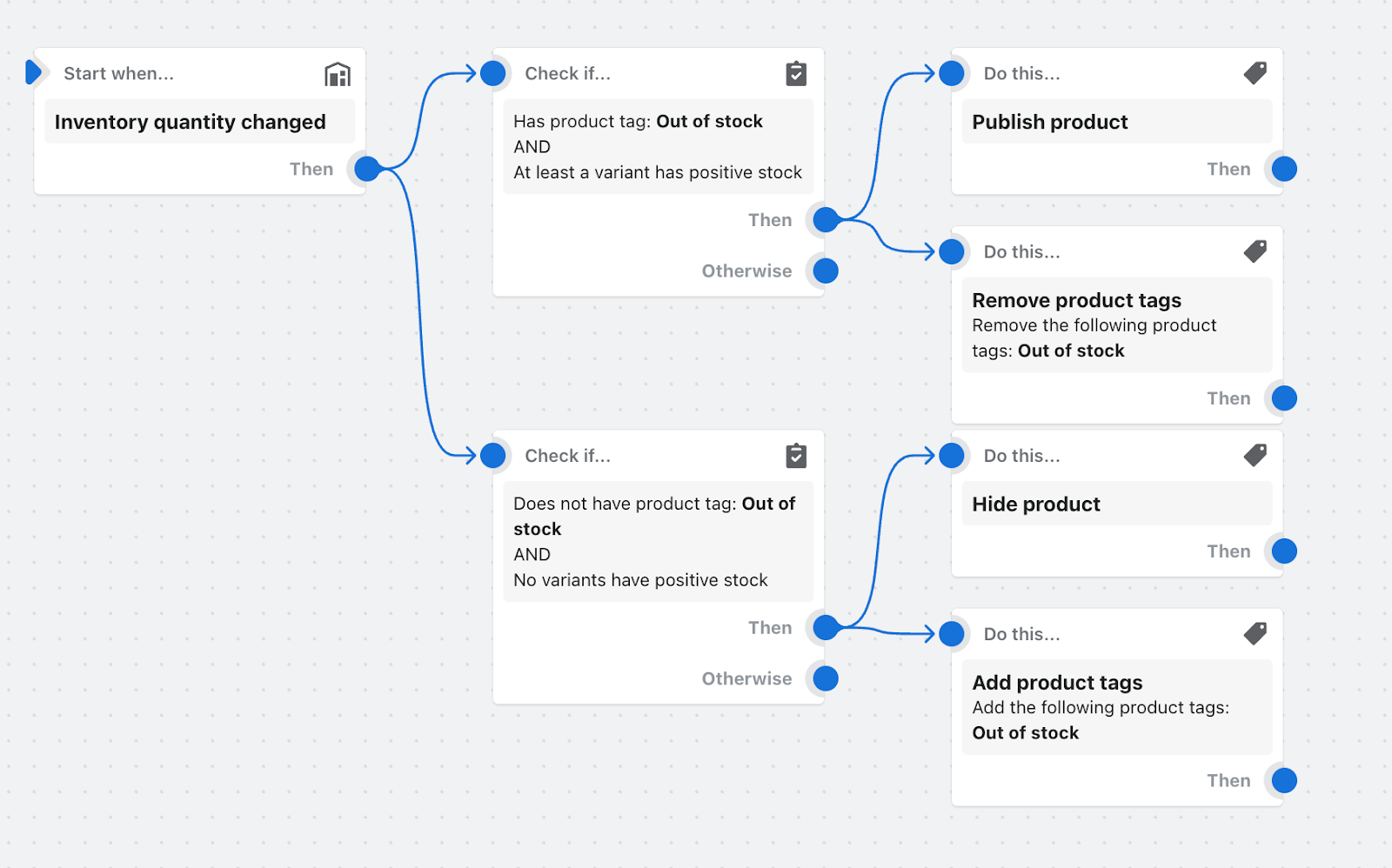
Shopify Flow automation example.
Titan AV managing director Kerri Economopoulos says: “By implementing Shopify a little over a year ago, it has allowed the company to overcome the challenges of maintaining brand consistency, managing inventory and orders, and analyzing performance across all our channels.”
Kerri adds that Titan AV has seen growth in several areas across the business, including a 10% uplift in sales, an 8% increase in AOV, and a 12% higher returning customer rate. “We have also saved significant time in managing multiple channels and processing orders through one centralized management platform,” she says.
Examples of multichannel marketing campaigns
LeSportsac
Lesportsac is famous for its sporty handbags and luggage. Despite its strong customer base, the brand’s ecommerce presence didn’t stack up to the in-person shopping experience. There were reports the site crashed when too many visitors arrived, and developmental changes to its customer-facing storefront took months to implement.
To address these concerns, Lesportsac revamped its web presence. It turned to Shopify to segment customers and personalized online marketing materials. Shoppers now get a customized experience with the brand based on previous touchpoints. And it’s made a difference according to Mallory Rosen, LeSportsac’s ecommerce manager. “There’s a very strong cohesion in all aspects of our branding now, from store to advertising to the website,” she says. “There’s no word in the dictionary to describe how completely different it is.”
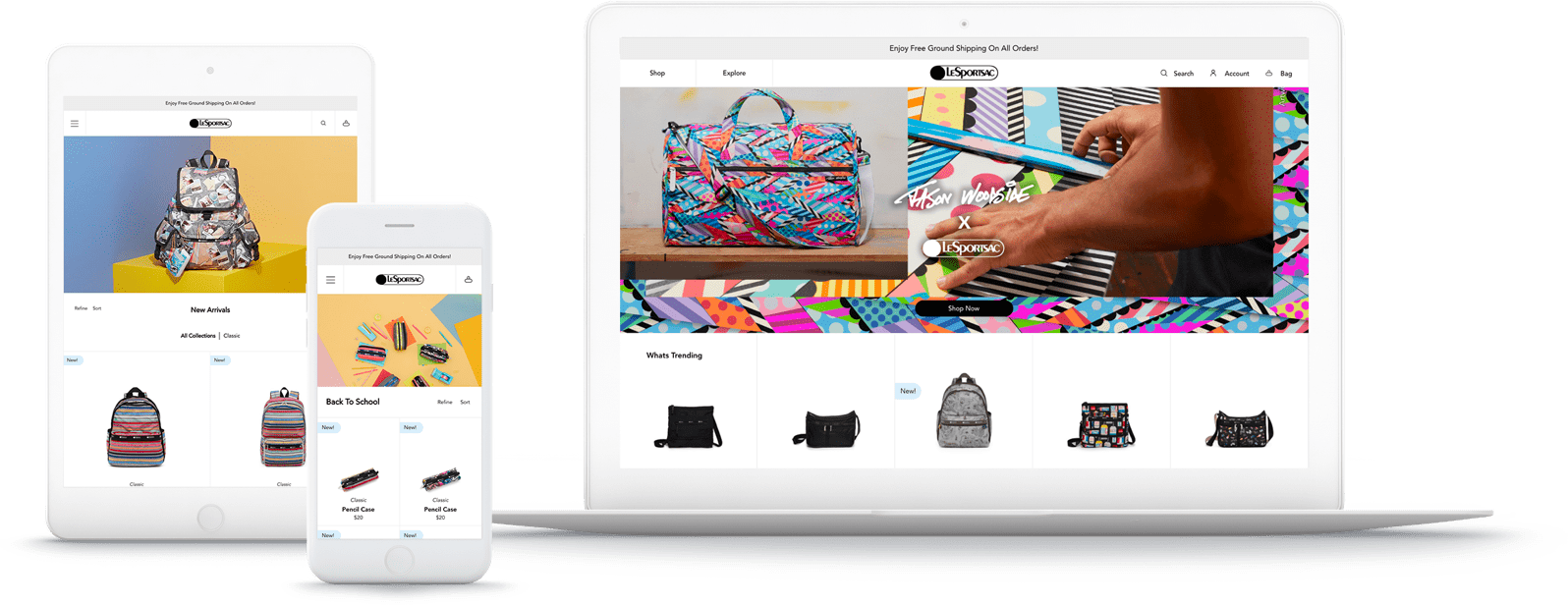
Lesportsac’s Shopify-powered online presence.
As a result of Lesportsac’s platform migration, the brand now provides a consistent experience to customers wherever they choose to shop.
Heatonist
Heatonist is a Shopify merchant that claims to sell the world’s best hot sauce.
The brand is active across the big three social media platforms—TikTok, Instagram, and Facebook—and regularly syndicates recipes, user-generated content, and news (like the opening of its Brooklyn store) across each channel.
Customers viewing this branded social content can browse the brand’s inventory through native storefronts or visit a retail location. Heatonist geotags its store location and tags products from native storefronts to divert followers toward its ecommerce website or brick-and-mortar store.
Regardless of how they choose to consume content and purchase products, customers get the same brand experience and ease of purchase cross-channel.
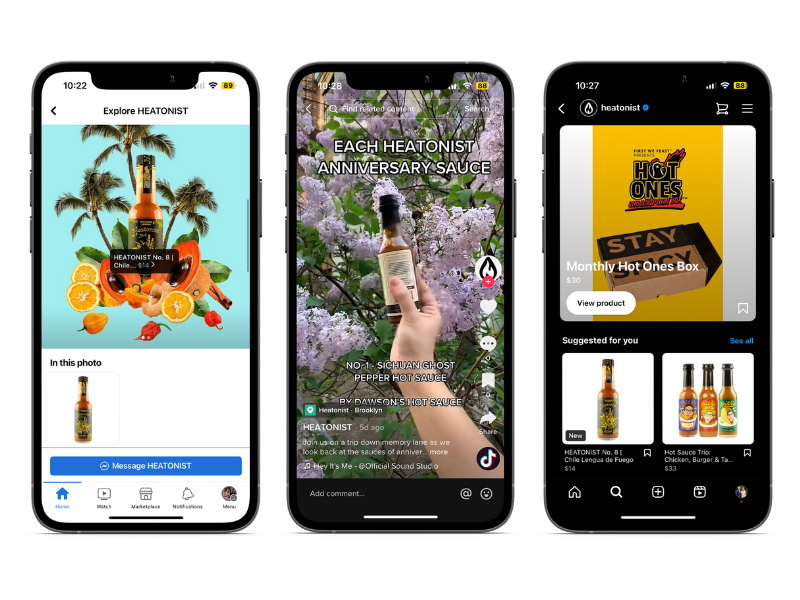
Heatonist on Facebook Shops, TikTok, and Instagram Shops.
Allbirds
Allbirds quickly became a direct-to-consumer (DTC) success story after reaching a reported billion-dollar valuation two years after launch.
Contributing to its success was its decision to invest in both an online presence and a robust brick-and-mortar strategy across the globe.
In an interview with Business of Fashion, Allbirds’ co-CEO Tim Brown said the brand wanted to build on a core childhood experience many of its customers share: visiting a shoe store and having their feet measured, only for the store assistant to say their size wasn’t available. “The biggest opportunity we saw really was to remake that experience, and create a seamless interplay between online and offline,” Tom says.
Fueling this cross-channel marketing is Allbirds’ mission to innovate using natural materials and become a sustainable company. Now boasting 54 stores worldwide, Tom says, “We see an uptick in digital traffic around those stores, and we’re able to use it as a customer acquisition vehicle for the best customers that we have within our ecosystem.”

An Allbirds retail store.
Not all store visitors become customers after a single visit to an Allbirds store. However, because Allbirds uses Shopify POS, its head of global retail operations Travis Boyce says: “We now have a measurement of the number of customers that are coming in to buy something we didn’t carry in the store that we otherwise wouldn’t have data on.”
Take the stress out of multichannel marketing
A successful multichannel marketing strategy meets customers where they buy. Whether that’s social media, marketplaces, or direct mail, implementing several marketing channels can not only capture customer attention, but also reinforce brand credibility.
Use these guidelines to create your multichannel marketing strategy. Enlist the help of Shopify Plus plan features—including native storefronts, PIM tool integrations, and advanced marketing analytics—to deliver seamless experiences to everyone, regardless of how far along the customer journey they are.
Use Shopify to power your multichannel marketing campaigns from the same back end that powers your ecommerce storefront. Learn more.
Read more
- 14 Video Ads That Blew Our Minds In 2015
- Back-to-School Marketing: Ideas, Stats & How to Automate the “Other” Black Friday
- Multi-Channel Management: Delighting Customers and Increasing Profits
- Reimagining Racial Equity in the Fashion Industry
- 7 Conversion Rate Optimization Experts Answer the Questions You Were Too Afraid to Ask
- B2B vs B2C Ecommerce: What’s The Difference?
- Conversion Rate Optimization: What Everyone Gets Wrong and How to Do It Right
- Composable Commerce: What It Means and if It’s Right for Your Business
Multichannel marketing FAQ
What is an example of multichannel marketing?
Patagonia is an example of multichannel marketing. The clothing retailer shares its commitment to sustainability across a range of online and offline channels, including social media, video, printed catalogs, and billboard advertising.
What is multichannel vs. omnichannel marketing?
Multichannel marketing is the process of delivering branded content to customers on the channels they’re using. Omnichannel marketing, however, references an individual customer’s previous interaction with a brand across several channels.
What is multichannel marketing and its benefits?
A multichannel marketing strategy helps retailers promote products anywhere their customers buy. The main benefits are greater brand awareness and a consistent brand image, which can positively influence sales.


